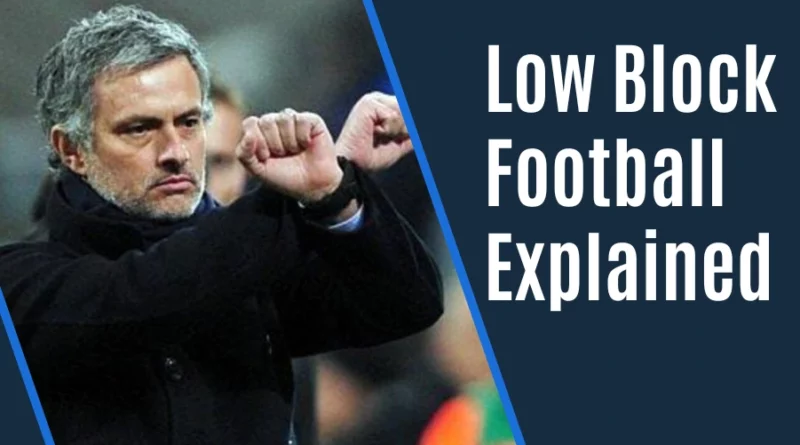What Is a Low Block in Football
Low block football tactics are a very common feature in the sport and are a very divisive topic amongst the fans. While some see it as a necessary tool, others view it as boring, negative, pragmatic, and even anti-football sometimes. But, across the decades, this approach has been quite effective and has produced top results for all various levels of clubs and managers. So, what exactly is a low block?
Low block football tactic is deployed by managers where the players of a team, while defending out of possession, stay narrow while staying closer to their own box. All ten outfield players stay very close to each other in a compact manner, creating a “block” for the opposition, making it harder to score. Meanwhile, as the attacking team deploys almost all of its players in the opposition half, there is a lot of space behind, which is exploited by the teams with a quick counterattack, resulting in goals.
In this post, we will have a deeper discussion about the various aspects of this tactic and the possible advantages and disadvantages whilst using it.
Football Low Block Explained
Teams of different qualities use the low-block tactic, often in multiple scenarios. Some of the popular reasons why teams use it are listed below:
- Difference in the quality of teams: When a weaker team is facing a stronger side, they tend to stay narrow and compact, deploying this tactic so that they do not concede a lot of goals. It is quite popular in teams that are newly promoted into the league.
- Protecting a lead: When a team wants to protect a lead and see the game through, especially in knockout football, they use this low-block tactic so that the opposition will find it hard to get the equaliser or the winning goal.
- Playing with fewer men: We all know how quickly things can flare up in this sport, and as a result, sometimes teams lose a player so early in the game via a red card. In such situations, if the teams are not confident in winning the game with the remaining players, they decide to stay low and minimize the damage.
Also Read: An Ultimate Guide to Football Formations and Tactics (4-4-2, 4-3-3 and more)
Who Uses Low Block in Football?
Almost every manager in world football has deployed the low-block tactic at a certain point in their careers – whether it is to make sure they get to the next stage in a knockout match or seal a result in a nerve-wracking thriller. However, there are a few select managers at the top level whose identity is built around this tactic.
Jose Mourinho

Jose Mourinho, one of the most successful managers in the history of the sport, has deployed the low-block tactic to perfection in many of his teams he has coached. Whether it is the lethal, counter-attacking Real Madrid or the defensively compact Chelsea, or the treble-winning Inter Milan, Jose Mourinho’s teams are the masters of low block football. They know when to drop deep, how to stop the opposition, and find the right time to hit back and win the games. One of the most iconic moments in the sport was when this tactic was used by Jose Mourinho’s Inter Milan during the second leg of the semifinals of the UEFA Champions League to stop mighty Pep Guardiola’s Barcelona from qualifying for the final in 2009.
Diego Simeone

Diego Simeone, who is one of the best coaches in the world, has also used low block football to achieve success at Atletico Madrid. In a league where there are two powerhouses – Real Madrid and FC Barcelona, Diego Simeone’s Atletico Madrid has found immense success in the past few seasons, winning league titles and always competing at the highest level. The Argentine’s well-drilled teams have been a headache to deal with for many top managers.
Antonio Conte

Antonio Conte has dominated domestic football using low block football. His compact three at the back system, which was introduced for the first time in English football when he came to Chelsea, saw them winning the Premier League in style during the 2016-2017 season. They were fantastic defensively throughout that season, conceding just 33 goals. He dominated Serie A using this too, finding massive success at Juventus, Inter Milan, and his current side, Napoli, who are now in a title race with Simone Inzaghi’s Inter Milan – another coach who has been doing wonders at the Nerazzurri using this tactic.
Mikel Arteta

Mikel Arteta’s Arsenal have also been using this to perfection over the last few seasons. This low-ball tactic has made them one of the best defensive sides in world football, conceding very few goals. As a result, despite not winning the league title, they went toe-to-toe against Pep Guardiola’s Manchester City during the past few seasons.
Some other notable coaches who used low block football have coached lower-ranked sides, which helped them survive in the league and even find good success. Sean Dyche’s Burnley was a great example when they managed to stay in the Premier League for six seasons and even played European football during this period. Similarly, we have seen Nuno Espirito Santo coach Wolves to European football, and he is doing the same this season with Nottingham Forest.
Also Read: What Is an Inverted Fullback?
How to Beat a Low Block in Football?
While it looks like the low block tactic is basically a cheat code, there are ways to get around it and exploit it to your own good. Here are some of the popular ways that teams use to beat the low-block
Switching the play
When a team faces a low-block opposition, they can draw them to one side of the pitch by passing it around in that area and quickly switch it to the other side, as a space is created in that region now. As a result, teams can quickly take advantage of it and score a goal.
Scoring from long range
Sometimes, teams using the low-block tactic sit way too deep into the box, creating a lot of space outside of it. If a team has players who can shoot effectively from distance, they can be given the ball in that scenario.
Applying pressure
Sometimes teams crack and cannot contain the opposition for the full 90 minutes of a match. So, consistently persisting with attacks, maintaining pressure on the opposition will open spaces due to player errors, on which the attacking team can capitalize on.
Set-pieces
Set pieces are one of the most effective ways to beat low block teams. A well-drilled team on free-kick and corner kick routines usually finds it easy to score goals and successfully break a low-block
Pros and Cons of a Low Block
Like everything on this planet, there are two sides to a coin. The low block football tactic has its own pros and cons. Some of them are listed below.
Pros
- Defensive Solidity: Using a low block gives defensive solidity during a season and sometimes during a particular scenario in a match.
- Counter-attacks: If your team has pacy wingers and creative players who can pick a pass out to perfection, this tactic works extremely well because there are acres of space behind the opposite team.
- Chances of survival: If a team is newly promoted to a higher division, chances are they are the weakest team in the league. So, in order to survive, they need to make sure they do not concede a lot of goals and hope that they can knick results here and there. A low block tactician is a perfect fit for such clubs.
- Less Tiredness: When we compare it to the usual high-energy tactics like the Gegenpress, the players in low block teams do not use a lot of stamina, which is crucial in jam-packed schedules that each team has nowadays.
Cons
- Handling Pressure: When teams are constantly under the threat of attack, more often than not, they crack under pressure and concede silly goals. This also puts a huge dent in the confidence of the defenders and the goalkeeper, lowering their level.
- Less Entertainment: Fans in the stadium and watching at home usually want to see goals or at least consistent attacks. Teams who deploy the low block and hit on the counter are not usually that exciting, and most of their games end up as low-scoring affairs. The supporters are also less forgiving if the results do not go in their way because they are not getting the entertainment factor too.
- Creating Fewer Chances: While teams get better at not conceding goals, the chances of scoring goals for yourself go down when you are always spending time defending your own box.
Also Read: 10 Football Managers With the Most Trophies in History (Ranked)
FAQs
Q: What does low block mean in football?
A: Low block in football means staying deep and compact close to your own box while defending.
Q: Who successfully used low block in football?
A: Jose Mourinho, Antonio Conte, and Diego Simeone used the low block perfectly in football.
Q: How can we beat the low block tactic in football?
A: Low-block can be beaten by switching the play, scoring from set-pieces, and applying consistent pressure.
